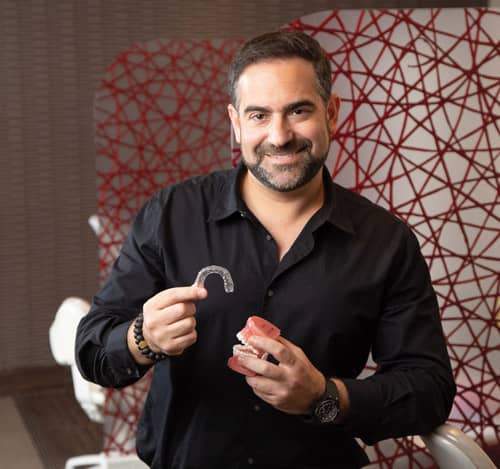Adam Schulhof, DMD, is considered one of the leading practitioners of lingual orthodontics in the United States. Today, at the Schulhof Center’s Manhattan office, 80% of his adult patients are treated with lingual. The thing is his journey into lingual had much to do with Align Technology’s introduction of Invisalign® in 2000 and how it introduced patients to aesthetic orthodontics. And it’s the current expansion of the clear aligner market in the wake of Align Technology’s expiring patents, that is taking him on a new journey—one with a new tool in his toolbox. A tool that gives him, as an orthodontic specialist, both a new way to meet patient demand for aesthetic treatment and a way to maintain his practice’s bottom line.
When Schulhof started his orthodontic career in 2003, fresh out of his residency at Columbia University, it was still the early days of Invisalign. Yet, in that short time span, Align’s direct-to-consumer marketing campaign piqued public interest in orthodontic treatment in a new way and it helped them verbalize what they really wanted: an aesthetic treatment option. However, as these potential patients walked into orthodontic offices for consults, many orthodontists like Schulhof weren’t as keen on the product and what it could do clinically; they just didn’t yet understand how to move teeth with this piece of plastic. So as potential patients left consults dissatisfied, their demand for an aesthetic option unmet, potential practice growth was squandered.
At the time, Schulhof knew he needed to grow the orthodontic side of his first office, a combo practice with pediatric dentist and dental school friend Darryl Engel, DMD, located in Oradell, NJ. The majority of the adolescent patients were still years away from orthodontics. So Schulhof set out to find a way to bridge the gap between consumer demand for aesthetic treatment and his clinical need for a reliable treatment modality. The answer: lingual braces.
“I knew that if I learned how to do this well, and if I could potentially offer better results than any labial system, then I can keep my patients happy by delivering them what they really want—which is complete and true aesthetics,” Schulhof recalls.
But even as Schulhof went heavy into lingual, he also tested the boundaries of what aligners could do. “I quickly realized that I’m a specialist. I can move teeth. I can move teeth with plastic. I can figure out a way to treat this patient [who wants aligners]. The key for me has always been that, as a specialist, I should have every tool in my belt and be able to use every tool to the utmost.”
A New Tool in the Toolbox
Last October, about 40 of Align’s early patents—those protecting the process Align uses to digitally plan and manufacture clear aligner sets for patients—expired. Over the next decade, an average of 23 of Align’s Invisalign-related patents are expected to expire annually. As a result, a number of orthodontic companies entered the clear aligner market segment for the first time this year. One such company is 3M Company’s Oral Care Division.
At the AAO Annual Session in Washington, DC, in May, the company launched 3M™ Clarity™ Aligners. This aligner joins 3M Oral Care’s aesthetic product line which includes 3M™ Clarity™ Advanced Ceramic Brackets and 3M™ Clarity™ SL Self-Ligating Appliance System. The aligner launch included clinician access to 3M’s web-based software, 3M™ Oral Care portal. The 3M portal allows orthodontists to plan patient treatment and order aligners at any time, from anywhere. Designed with orthodontists, the open, HIPAA compliant platform gives orthodontists flexibility to use the intraoral scanner of their choice and turn the case over to 3M for final setup and manufacturing. And for those orthodontists who want to set up their own cases, the portal will offer this option via an integration with uLab Systems treatment planning software in the near future.
Schulhof has been a long-time user of 3M Clarity Ceramic brackets and the 3M™ Incognito™ Appliance System, the company’s lingual appliance system. For the first time though, he feels he has a full arsenal of tools at his disposal with Clarity Aligners.
Previously, when faced with cases he knew he could treat with an aligner on the upper and brackets on the lower, he felt limited by Invisalign. “When there was only Invisalign, if I ordered an upper Invisalign, I couldn’t give the patient something else on the lower. Technically, I could, but it would cost a fortune because Invisalign charges me for the full case. I’m a small business owner; I had to think about the bottom line,” says Schulhof, who was a Clarity Aligners beta user.

Schulhof and orthodontic assistant Danielle Diaz work on a patient in the practice’s Oradell, NJ, office.
“One of the key things for me with the Clarity Aligners is that they charge you pretty much per piece. If I only order six aligners, I’m only paying for six aligners. If I only order an upper or lower, I only pay for an upper or lower. So, I have so much more flexibility when I see a patient to discuss with them not just their malocclusion and what’s going on in their mouth, but their personality, their lifestyle, and what they want.”
Schulhof cites the example of a recent patient to illustrate what this flexibility means. “Just the other day I had a patient who gave me the biggest hug in the middle of the clinic because she had gone to multiple orthodontists who told her she wasn’t a candidate for aligners, and she really wanted aligners.”
And why wasn’t she a candidate? Because she had an underbite and severe crowding on the lower jaw. In fact, on the lower jaw, one tooth would need to be extracted to align them and get them behind the upper teeth. Oh, and she was getting married in less than a year and didn’t want to commit to two-plus years of aligner treatment. When the patient asked if there was anything Schulhof could do for her, he responded, “Heck yeah!”
The tooth was extracted and aligners used on top and ceramic brackets on the bottom. “I know I can have that space closed with regular labial ceramic brackets before her wedding. Her upper arch is going to be completely leveled and aligned with her aligner.
“For me as a business owner, I didn’t pay a full lab fee for a full upper-lower comprehensive case. All I paid for is the aligners they’re going to send me. So, the upper arch was 14 aligners; I paid for 14 aligners. My overhead is kept under control and I can charge the patient a fair fee. [As a small business owner], I’m happy. Biomechanically, I’m happy. And the patient is happy from an aesthetic perspective. And I was the only doctor in town who was able to give her what she actually wanted. Yes, she compromised a little bit on the bottom because she didn’t get aligners. But she’s ok with that because her bottom teeth don’t show when she smiles.”
Another reason Schulhof has embraced Clarity Aligners is its software platform—the 3M Oral Care portal. Schulhof, a self-described Mac guy, had to create workarounds to run Align’s Windows-based ClinCheck Pro on his practice’s Macs. But with the web-based 3M Oral Care portal, he can be on any platform, and what’s more, he can access it remotely on a laptop, or even his cellphone (even though it’s not yet optimized for mobile use).
Patients Trust the Specialist

Schulhof with office staff (front row, left to right) Karolina Peranek, Danielle Sorrenti, Christina Citakian (rear row, left to right) Samantha Puzzo, Danielle Diaz, Alicia Temurrcu, and Alyssa Puzio.
Today, many orthodontists think identifying their practice with one product is a way to differentiate themselves from the competition—ie, touting themselves as a #1 Invisalign provider. Schulhof, however, heartily disagrees.
“There are a million Invisalign providers out there [including general dentists],” he says. “You differentiate yourself by saying you treat every patient how they want to be treated and need to be treated, and that you are going to be the best at deciding together with the patient what’s going to get them treated the best, the fastest, etc.”
Currently, Schulhof treats about 85% to 90% of his aligner patients with Clarity Aligners. The remaining 10% to 15% are treated with Invisalign, simply because that’s what the patient wants.

Schulhof and orthodontic assistant Alyssa Puzio (left) clap as patient Max Shor completes treatment.
“When I first started offering Clarity Aligners to patients, I was worried about the kickback: ‘What is this? I’ve never heard of this.’ But I was surprised how many patients instead said, ‘Whatever you think. You’re the doctor,’” he says. “But you will just have that 10% who are like, ‘Well, I’ve heard of Invisalign. My friends have Invisalign. So, I want Invisalign.’ My response: All right, cool. That’s fine.
“I thought it would be the other way around. But in reality, most patients defer to you as the specialist and the doctor. They came to you for a reason, especially if that’s how you set up your reputation.”
In the end, that’s the key here: It’s not about the appliance. That’s just a tool. It’s about you as the doctor. The patient is placing their trust in you, not the appliance.
“As an orthodontist, you’re a specialist,” Schulhof adds. “Do what you do best. Just make sure you have every single tool and that you convey to the patient what tool is going to work best for them.” OP







